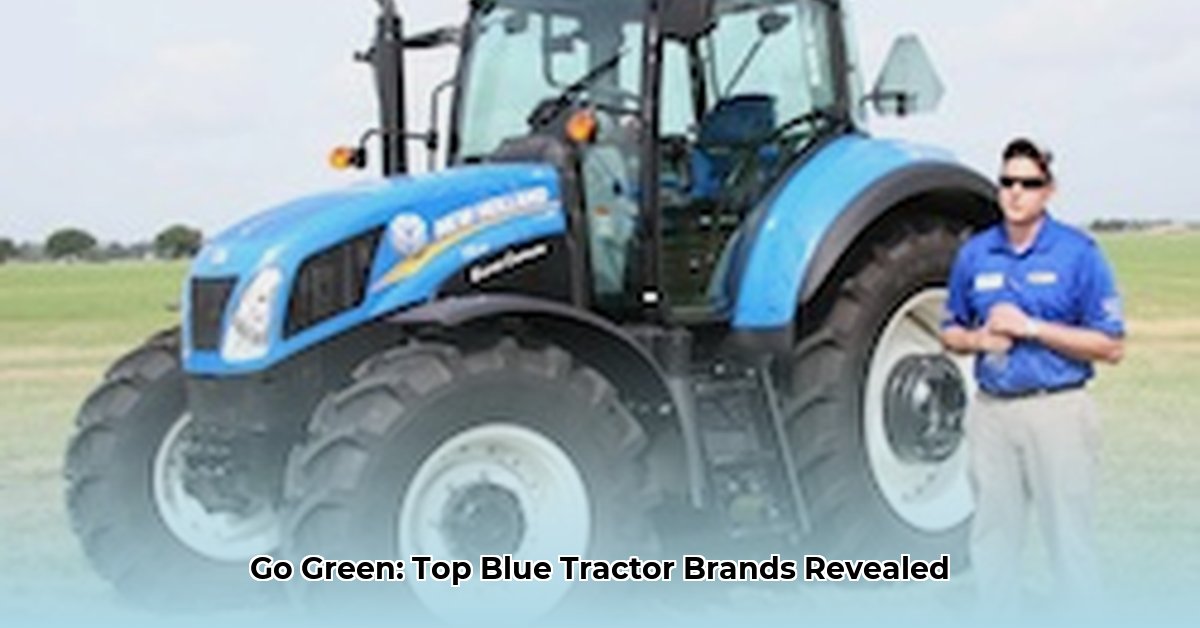
The iconic blue tractor, a symbol of agricultural prowess for generations, is undergoing a significant transformation. This article explores the history, current landscape, technological advancements, and sustainability considerations within the blue tractor market, offering actionable insights for farmers, investors, manufacturers, and policymakers. For more information on blue tractor brands, visit this helpful resource.
A Colorful History: From Ford's Legacy to Modern Competition
The association of blue with farm equipment is deeply rooted in Ford's early dominance. Their robust tractors became symbols of agricultural progress. However, the market evolved. The sale of Ford's tractor division ultimately led to the emergence of New Holland, preserving the blue legacy. Today, numerous manufacturers offer blue tractors, creating a competitive and diverse market.
The Current Landscape: A Qualitative Overview
Several major players now contend in the blue tractor arena. New Holland, leveraging its extensive history, maintains a strong global presence. Other manufacturers, often specializing in specific geographic regions or farming techniques, offer compelling alternatives. While precise market share data is difficult to obtain, the market's dynamism and competitiveness are undeniable. This diversity provides farmers with a wide range of choices to meet their individual needs. Do you prioritize established brand reliability or innovative features from a newer contender?
Technological Advancements: Efficiency, Precision, and Autonomy
Modern blue tractors are characterized by significant technological improvements. Engine efficiency has dramatically increased, resulting in lower fuel consumption and reduced operating costs. Precision farming technologies, such as GPS-guided systems and automated controls, are becoming increasingly common, enabling targeted fertilizer and pesticide application. This minimizes waste, maximizes crop yields, and improves resource stewardship. Furthermore, the advent of autonomous tractors promises even greater efficiency gains, reduced labor costs, and enhanced safety. How will these advancements shape the future of farming?
Sustainability: A Central Concern
Environmental concerns are no longer peripheral; they are central to the future of agriculture. Consumers and governments alike are demanding environmentally responsible practices. Many blue tractor manufacturers are responding by focusing on fuel efficiency, emissions reduction, and exploring alternative fuel sources. This shift towards sustainability presents both opportunities and challenges for the industry. What role will alternative fuels play in the next decade?
Actionable Insights for Key Stakeholders
The blue tractor market's impact extends beyond the machines themselves. The following provides actionable advice for key stakeholders:
1. For Tractor Manufacturers:
- Invest heavily in research and development of eco-friendly technologies and alternative fuel sources. This is crucial to meeting the increasing demand for sustainable solutions in agriculture.
- Develop tractors tailored to the specific requirements of diverse farming methods and geographical locations, creating a customizable approach for varied agricultural contexts.
- Integrate advanced data analytics and precision agriculture tools to add significant value for farmers, enhancing the efficiency and profitability of their operations.
2. For Farmers and Agricultural Businesses:
- Conduct thorough comparisons of tractor models before purchasing, prioritizing return on investment (ROI). Investigate leasing or financing options to improve financial flexibility.
- Consider long-term maintenance costs and environmental impacts in addition to the initial purchase price. Sustainability is a long-term investment that yields considerable returns.
- Invest in training to maximize the effectiveness of advanced technologies such as GPS guidance and automated features. This ensures farmers can fully capitalize on the benefits of technological advancement.
3. For Investors and Financial Institutions:
- Conduct thorough due diligence, focusing on the financial performance and sustainability initiatives of blue tractor manufacturers before investment. Sustainability is no longer a niche concern; it is a key factor in responsible and successful investment strategies.
- Prioritize companies at the forefront of innovation in sustainable agricultural technologies, recognizing that future growth will be driven by eco-friendly solutions.
- Support ventures focused on sustainable agricultural practices, as these represent significant opportunities for long-term profitability and positive environmental impact.
4. For Governments and Regulatory Bodies:
- Implement stricter emission standards for agricultural equipment and provide incentives for adopting sustainable farming practices and technologies. Regulatory frameworks are essential to driving wider adoption of sustainable solutions.
- Invest in farmer education programs to promote adoption of new technologies and sustainable farming techniques. Equipping farmers with the necessary knowledge empowers them to make informed choices.
- Develop long-term agricultural policies that support sustainable practices and responsible resource management. This ensures the long-term health and viability of agricultural practices.
The Future of Blue: A Sustainable Outlook
The future of the blue tractor market is dynamic and driven by technological innovation and the growing importance of sustainability. Companies that adapt to these changes, embrace innovation, and effectively meet the evolving needs of farmers will thrive. The key to success lies in the harmonious integration of efficiency and environmental responsibility, creating a future where productivity and sustainability work in perfect synergy. What innovative solutions will emerge in the next five years?